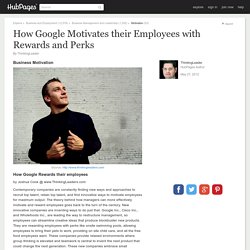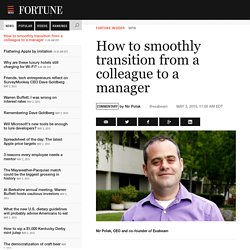

How Google Motivates their Employees with Rewards and Perks. By Joshua Cook @ www.ThinkingLeaders.com Contemporary companies are constantly finding new ways and approaches to recruit top talent, retain top talent, and find innovative ways to motivate employees for maximum output.

The theory behind how managers can more effectively motivate and reward employees goes back to the turn of the century. New innovative companies are inventing ways to do just that. Google Inc., Cisco Inc., and Wholefoods Inc., are leading the way to restructure management, so employees can streamline creative ideas that produce blockbuster new products. They are rewarding employees with perks like onsite swimming pools, allowing employees to bring their pets to work, providing on site child care, and all the free food employees want. Google's motivation methods. O.C.E.A.N. lecture on most important traits 4 Dr Dax's class. Team vs Group. Team vs Group?

This article highlights differences between team leader and group leader roles. We include a study of leadership issues in transition from group to team. When setting up either, it is worth considering the role the individuals are to play. Ask yourself whether organizational goals will be best achieved by a team or a group. Where does responsibility lie? The first team vs group issue to consider is where the focus of overall responsibility for performance si located. One of the key differences between the team leadership and group leadership is: "Who is responsible for delivering the total outcome of the individuals' efforts?
" Individual responsibilities In a group each member is responsible for only their own individual contributions. Individuals need not have any concern about what other members of the group achieve. Group members are likely to develop an individual relationship with the group leader. Collective responsibility Team vs Group: Who owns the results? For example: Apples organizational structure. Apple's organizational chart. How to smoothly transition from a colleague to a manager. The Leadership Insider network is an online community where the most thoughtful and influential people in business contribute answers to timely questions about careers and leadership.

Today’s answer to the question “How do you go from a worker bee to a decision maker?” Is by Nir Polak, CEO and co-founder of Exabeam. Navigating the transition from worker bee to decision maker can be tricky. Often times you’re ready for the next step in your career, but apprehensive about the additional pressure more responsibilities will bring. Relationships and priorities will change. Be a mentorOver the years, I’ve developed great relationships with brilliant and talented colleagues, some of whom have continued to work with me at Exabeam.
Push your boundariesStaying within your comfort zone is easy and tempting, but ultimately very limiting. CSUCI MGT307-05 Class Collection. Women in Management: Delusions of Progress. The accepted message on gender disparity in the workplace has for the past 10 to 15 years been one of acknowledgment and reassurance: Yes, women represent just 3% of Fortune 500 CEOs and less than 15% of corporate executives at top companies worldwide, but give it time.

It’ll change. After all, women also make up 40% of the global workforce, with double-digit growth in certain countries. They’re earning advanced professional degrees in record numbers and in some areas surpassing men. Companies have implemented programs to fix structural biases against women and support their full participation in leadership. Women are finally poised to make it to the top, the argument goes. If only that were true. “Frankly, the fact that the pipeline is not as healthy as we’d thought is both surprising and disappointing,” says Jim Turley, the chairman and CEO of Ernst & Young, a sponsor of the research, which tracked more than 4,100 MBA students who graduated between 1996 and 2007. First Post-MBA Jobs.